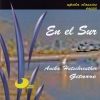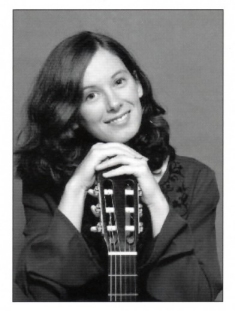En el Sur
 En el Sur
En el Sur Anika Hutschreuther - Guitar
Track-List:
Dionisio Aguado (1784-1849)
Prelude und Rondo Nr. 2 a-moll
1. Prelude

2. Rondo

Astor Piazzolla (1921-1992)
Las Estaciones Porteñas
3. Primavera Portña

4. Verano Porteño

5. Ontoño

6. Invierno Porteño

Leo Brouwer (*1939)
El Decameron Negro
7. La Arpa del Guerrero

8. La Hida de los Amantes por la Valle de los Ecos

9. Ballada de la Doncella Enamorada

Alberto Ginastera (1916-1983)
Sonata op 47
10. Esordio

11. Scherzo

12. Canto

13. Finale

Gaspar Sanz (1640-1710)
14. Canarios

Dionisio Aguado (1784-1849) was a respected Spanish guitarist and composer. After 1826 he lived in Paris, where he made the acquaintance of the Spanish guitarist Fernando Sor. The two musicians managed, despite certain differences of opinion regarding playing technique and playing posture, to become friends, and played concerts for the highest echelons of Parisian society. Guitar construction was at that time undergoing great changes. The cingue corde Baroque guitar was giving way to an instrument with six strings. Tabulature notation was now considered obsolete. Playing technique had to be adapted to the new musical exigiencies. Aguado wrote the didactic work "Nuovo Método para guitarra", and composed countless etudes, as well as, among many other such pieces, "Tres Rondos brilliantes" (1920), which took account of the new type of bridge construction.
The Argentinian Astor Piazzolla (1921-1992) is considered the founder of the Tango Nuevo. Already as a child he had learned to play piano and, to humour his father, the bandoneon. Initially he rejected the tango (which his father listened to night and day); his inclination was more towards jazz and the music of Bach. After eleven years in New York, the 16-year old returned with his family to Buenos Aires. Here he heard for the first time the new Tango Argentino, which he embraced with enthusiasm. However, he decided initially on a conservative musical education, and studied composition with the young Alberto Ginastera, and with Nadia Boulanger in Paris. Here he concealed his Tango compositions, because in his homeland the tango had a dubious reputation. However, it was primarily on the basis of these efforts that Nadia Boulanger recognized Piazzolla's exceptional talent. Back in Argentinia Piazzolla further developed his tango style, making use of jazz harmonies as well as ideas from Igor Stravinsky and Bela Bartòk; and experimenting with glissandi, percussive effects, contrasts, and syncopations. He enlarged the tango form and incorporated it in ballet, oratorio, suite, and concerto. The character of his music is also determined to a considerable extent by the nature of the ensemble for which it is written. Glissandi of the entire orchestra and rhythmic chord sequences are contrasted with elegaic solo passages. "The Four Seasons" (the subtitle "porteño" refers to the area around Buenos Aires) is an acknowledgement of Antonio Vivaldi. Originally written for his quintet, the piece has appeared in many instrumentations. The version on this album for solo guitar was arranged by Sergio Assad.
The Cuban composer and guitarist Leo Brouwer (*1939) boasts an impressive oeuvre - with emphasis on works for guitar - which he is constantly adding to. No fewer than eleven concerti for guitar and orchestra have flowed from his pen, in addition to numerous pieces for guitar solo. His early works, from a period when he was selftaught, are influenced by Cuban rhythms. In 1961, at the Warsaw Autumn, he was exposed to the ideas and exponents of the European avant garde. Brouwer experimented with new compositional techniques such as graphic notation, twelve-tone and serial music, and minimalism. He incorporated these into his music, thereby developing his own unique style. Leo Brouwer characterizes his current style as "National hyper-romanticism". In a sense, it represents a return to tonality, which permits listeners to approach his music on a more intimate level. Traditional forms and rhythms gain a renewed prominence. Leo Brouwer, himself a superb guitarist, is second to none in his ability to harmonize his ideas with the technical possibilities and limitations of this instrument: this allows the musical ideas and content to occupy the listener's attention, without being distracted by any evidence of technical difficulties. El Decameron Negro was composed by Leo Brouwer in 1981 for the guitarist Sharon Isbin; it is his first guitar composition in the new style. The movements are freely based on African folk tales collected by the ethnologist Leo Frobenius (1873-1938). In the first movement, "The Warriors' Harps", hardedged, martial passages alternate with romantic ones. "The Flight of the Lovers through the Valley of Echoes" is a painting in sound. The vastness of the landscape, the yearning of the lovers, and finally the flight on horseback are expressively depicted. "The Ballad of the lovestruck Maiden" consists of contrasting elements in rondo form: the romantic melody versus the quick off-beat rhythms. The end is characterized by Brouwer's "new" placatory harmonic style spiced with a little tease.
Alberto Ginastera (1916-1983), Argentina, studied composition at the Conservatory in Buenos Aires. From his youth he was celebrated as a composer; today he is counted among the most important South American composers of the 20th century. He composed operas; ballets; piano, violin, and cello concerti; other orchestral works; chamber music. The Sonata op. 47 is his only work for solo guitar and was written for the guitarist Carlos Barbosa-Lima. Ginastera's music was initially strongly in the tradition of Argentinian folklore. Many pieces are in 6/8 time with a characteristic rhythm, and use simple melodies. Ginastera labels this period of his compositional output as "Objective Nationalism". Thereupon he travelled to the US, where he broadened his palette of compositional techniques: thus was born "Subjective Nationalism". Argentinian music remains an important component of his musical language. Rhythm and melodic line, as well as large contrasts continue to be important. Melodies from folklore are used in a symbolic way.In the neo-expressionistic style of his final period, Ginastera eschews direct folk material. The relationship to his homeland is more subtle: strong ostinato rhythms, the serenity and vastness of the pampa: the magic of this landscape is acoustically conjured. In this period dissonances and free tonality have become part of his musical language. The Sonata op. 47 belongs to this period.
 The Spaniard Gaspar Sanz (1640-1710) studied music, theology, and philosophy. He was organist at the royal court in Naples, where he learned to play the "chitarra spagnola". Nowadays this guitar is referred to as the baroque guitar.Gaspar Sanz authored three didactic works for guitar, which are still very well known, among other things for the Spanish and Italian dances quoted therein. In 1954 Joaquín Rodrigo composed the "Fantasía para un gentilhombre" for guitar and orchestra; in this he makes use of five of the aforementioned dances. Thus these melodies are still (or again) current. The Canario is recorded on a baroque guitar; thus rendered we hear the typical sound, as well as the Rasgueado and Campanella technique.
The Spaniard Gaspar Sanz (1640-1710) studied music, theology, and philosophy. He was organist at the royal court in Naples, where he learned to play the "chitarra spagnola". Nowadays this guitar is referred to as the baroque guitar.Gaspar Sanz authored three didactic works for guitar, which are still very well known, among other things for the Spanish and Italian dances quoted therein. In 1954 Joaquín Rodrigo composed the "Fantasía para un gentilhombre" for guitar and orchestra; in this he makes use of five of the aforementioned dances. Thus these melodies are still (or again) current. The Canario is recorded on a baroque guitar; thus rendered we hear the typical sound, as well as the Rasgueado and Campanella technique.Anika Hutschreuther was born 1976 in Schleswig. She started playing guitar at the age of 13. Her musical studies led her from Stuttgart to Kassel to Hamburg, where she completed the performance exam with distinction in October 2010. At the music academy in Kassel her instructor was Michael Tröster, who initiated the CD "Beyond the Rainbow" with the guitar ensemble. In Hamburg her instructors were the professors Klaus Hempel and Olaf van Gonnissen. During her studies she received support from the Markel Foundation. In 2006 she was a semi-finalist in the Karl-Scheit-Competition in Vienna; in the same year she won the Concours d'Ufam in Paris, and won a prize at the International Guitar Competition in Koper, Slovenia. In 2010 she received the Herman-and-Milena-Ebel Prize for outstanding young musicians.
(translation by Reinhard von Berg)
Back to the list